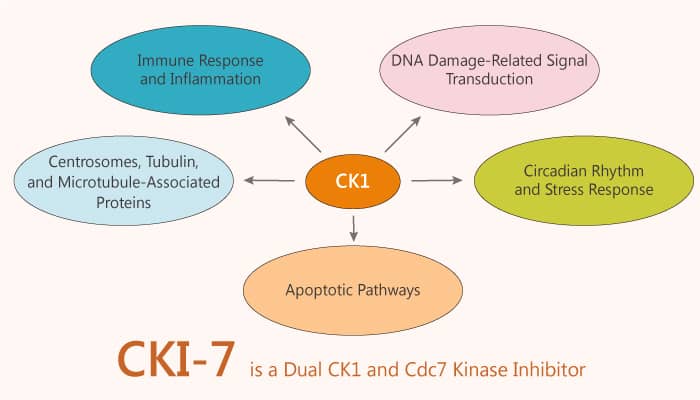Protein phosphorylation plays a fundamental role in the regulation of a variety of cellular processes. Casein kinase I (CK1) is a cyclic nucleotide independent kinase. It is highly purified from various tissues, including calf thymus, rabbit reticulocytes, liver, and skeletal muscle. The widespread distribution of CK1 suggests its importance in cell function. CK1 is specificity for the phosphate donor. Cdc7 is a heterodimeric serine/threonine-protein kinase. It is a key regulator in the process of initiation of DNA replication and the G1 to S phase transition. In this study, CKI-7 is a potent and ATP-competitive CK1 inhibitor with an IC50 of 6 μM and a Ki of 8.5 μM. CKI-7 is a selective Cdc7 kinase inhibitor. It also inhibits SGK, S6K1 and mitogen- and stress-activated protein kinase-1 (MSK1).
CKI-7 is a Potent CK1 and Cdc7 Kinase inhibitor and shows anti-cancer activity.

CKI-7 treatment significantly increases the expression of the early neuroectodermal marker Sox1 and the number of cells positive for the neural markers nestin and βIII-tubulin, in a concentration-dependent manner. In addition, CKI-7 suppresses SFEB-induced β-catenin stabilization on day 5. Therefore, it indicates CKI-7 inhibits Wnt signaling. CKI-7 induces cytotoxicity of established leukemia and lymphoma cell lines in culture with IC50s in the low nanomolar range. CKI-7 likewise induced cytotoxicity of MDR1 overexpressing cell lines with similar IC50s. Furthermore, it also induces cytotoxicity of patient-derived primary acute leukemia tumor cells in vitro at similarly low nanomolar concentrations.
In vivo, CKI-7 displays dose-dependent anti-tumor activity in a SCID-Beige mouse systemic tumor model utilizing a recently isolated Philadelphia chromosome-positive acute lymphoblastic leukemia cell line. Moreover, Standard cell cycle synchronization studies established that exposure to CKI-7 results in cell cycle-dependent caspase 3 activation and apoptotic cell death.
In conclusion, CKI-7 is a potent and ATP-competitive CK1 inhibitor, and it also inhibits Cdc7. Thus, it is an equally promising novel cancer therapeutic agent.
Reference:
Mark G. Frattini, et al.Blood (2008) 112 (11): 2668.
Chijiwa T, et al. J Biol Chem. 1989 Mar 25;264(9):4924-7.